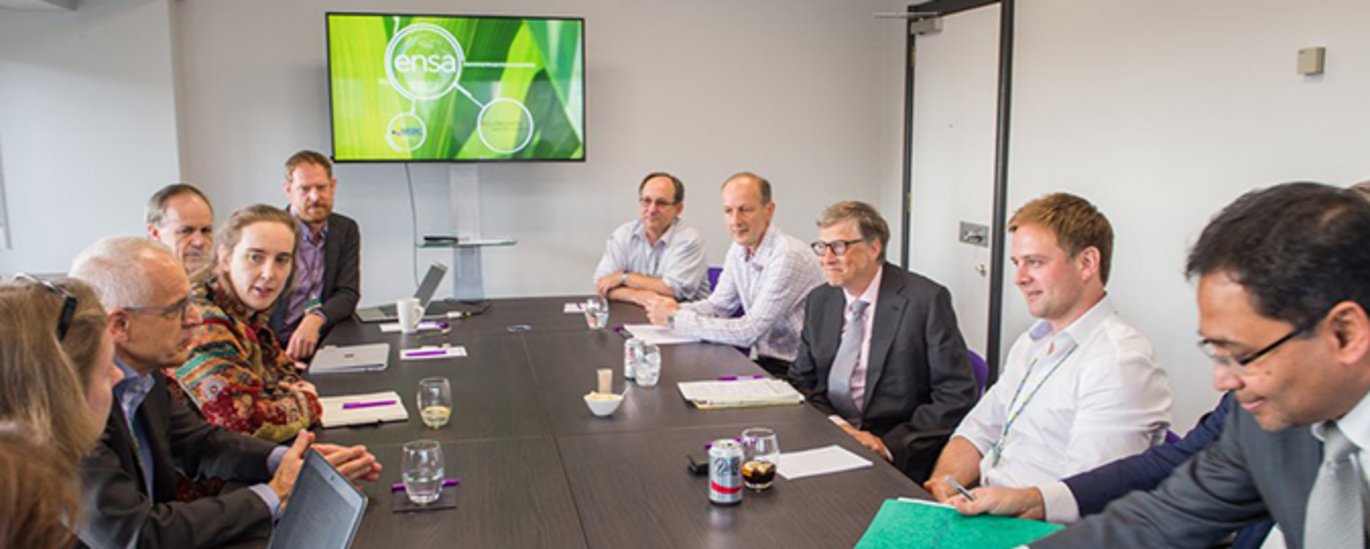Bill Gates met with researchers from Aarhus University
Bill Gates recently met with researchers from the Department of Molecular Biology and Genetics at Aarhus University to discuss the sustainable use of biological nitrogen fixation that allows legumes to use atmospheric dinitrogen as a nitrogen source.

Plants need fertilisers in the form of nitrogen in order to grow, and for environmental reasons, there have been many attempts to reduce the use of fertilisers during the past few years without reducing production. Therefore, there has been a focus on the possibilities of utilising knowledge about the legumes' ability to form their own fertiliser in symbiosis with nitrogen fixing rhizobium bacteria.
Through a comprehensive basic research project, Professor Jens Stougaard and his colleagues at the Department of Molecular Biology and Genetics at Aarhus University have identified which genes enable legumes to establish symbiosis with rhizobium bacteria.
This research has opened new biotechnology opportunities to transfer the symbiosis to include plants outside the leguminous family. In this context, it is crucial to understand why the plants do not perceive the rhizobium bacteria as pathogenic organisms to be eliminated, but on the contrary, as a kind of collaborator who needs access to the root of the plant.
The research group has now established the basis for understanding the mechanisms plants use to respond to different soil microbes and distinguish symbionts from pathogens, in other words, to tell a friend from a foe. The research shows that legume root cells have similar receptors that are able to separately perceive chitin, which activates responses to pathogens, and lipochitin-oligosaccharides (Nod factors), which activates endosymbiosis with rhizobial bacteria. For the 80-90 % of land plants that permit symbiotic microorganisms such as rhizobia or mycorrhizal fungi to infect their tissues this ability to differentiate mutualistic microbes from pathogens is crucial for their survival. The results, published in the internationally recognized journal PNAS, pave the way for new studies of signal transduction pathways leading to symbiosis and defense responses.
Professor Jens Stougaard and Simona Radutoiu had the opportunity to discuss the perspective for increasing the use of symbiotic nitrogen fixation in sustainable agriculture with Bill Gates and his staff during the Grand Challenges Conference at the Queen Elisabeth II Centre in London. All participants were excited about the perspectives and engaged in discussing the many challenges in translating basic plant-microbe research into sustainable solutions.
Through his fund, Bill Gates is known for funding projects that can benefit developing countries.
Link to the scientific article in PNAS (Proceedings of the National Academy of Sciences of the United States of America) ”Receptor-mediated chitin perception in legume roots is functionally separable from Nod factor perception”: http://www.pnas.org/content/114/38/E8118.abstract
For more information, please contact
Professor Jens Stougaard
Department of Molecular Biology and Genetics
Aarhus University, Denmark
+45 6020 2649 - stougaard@mb.au.dk
Lektor Simona Radutoiu
Department of Molecular Biology and Genetics
Aarhus University, Denmark
+45 8715 5498 - radutoiu@mbg.au.dk
